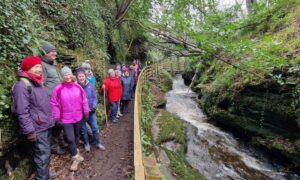*Photograph: Joe Buckley
SHANNON TOWN’s flood defences scheme is currently at the environmental and design stage.
Acting Director of Services in the Shannon Municipal District, Siobhán McNulty outlined that the scheme is presently at the environmental and design stage.
Consultants, RPS led a public consultation event at the end of October. They are on the steering group for the project alongside Clare County Council, the OPW and the Shannon Airport Group.
All third-party survey works (Topo Survey, Ground Investigations, CCTV, Flow-Water Level-Rainfall and Geophysical Survey) have now been completed.
Close to €40m will have to be spent on the Shannon Town and Environs Flood Relief Scheme. Failure to complete works could leave damages in the region of €270m in a worst-case scenario.
Among the options under consideration to deal with Shannon’s coastal flood risk are a tidal barrage, an upgrade of existing defences, a realignment of current defences or and an abandonment of breakwater which would result in significantly higher walls along N19 and wastewater treatment plant access road.
An options assessment, scheme development and design are among the current priorities regarding the scheme. This will involve the finalisation of the options selection process, an identification of a preferred option, a completion of environmental assessments and environmental impact assessment and reporting (EIAR).
Stage two on the next steps associated with the scheme are further public and stakeholder engagement, planning permission and a compulsory purchase order if required.
Latest timelines are for construction to commence at the end of 2026 with the project’s targeted completion set for 2030.
Speaking at a meeting of the Shannon Municipal District, Cllr Gerry Flynn (IND) noted, “the flood defence mechanisms have made huge differences where they have been implemented, Ennis is working very well, it is a while since we’ve had issues of flooding, if there are no hitches with planning it will be 2030 before the handover of that scheme (Shannon) to the Council”.
He felt a “fairly good submission” was put in regarding the N19 to try get extra facilities “like connecting the footpath from Shannon Town to Drumgeely embraced with the plan. I also asked for cycle lanes so as not to have cycling and pedestrian lanes competing with each other. It takes forever and a day, they said they were making the road wide enough to allow a turnaround process is something happened, we were always worried an accident could close the airport down because it is only one road in and one road out”.
Cllr Pat O’Gorman (FF) acknowledged there is “a lot of detail involved and a lot of work going on behind the scenes” for Shannon’s flood defences. “There is a substantial amount of work starting from the Golf Course and beyond where the old de Beers clubhouse was”.
O’Gorman added, “It will be a major development for Shannon and the people of Shannon will be available to insure their houses against floods”.
At the time of the development of Shannon Town and Shannon Airport in the 1940s and 1950s, a series of embankments were constructed along the north side of the Shannon Estuary to separate the low-lying lands from the tidal waters to the south which would facilitate this development.
Shannon is viewed as an area at risk of flooding from both coastal and fluvial sources, according to the OPW. The OPW, working in partnership with Clare County Council and other Local Authorities completed the Shannon Catchment Flood Risk Assessment and Management (CFRAM) Study. The Shannon CFRAM Study Area identified Shannon Town & Shannon Airport as an Area of Further Assessment (AFA) and IRR Individual Risk Receptor (IRR) respectively and concluded that a flood relief scheme would be viable and effective for the community.
In July 2020 OPW in partnership with Clare County Council appointed RPS to further assess the CFRAM Study identified options and prepare a detailed scheme for Shannon which is economically viable and environmentally sustainable. The entire scheme will be implemented in five different stages. Stage I is currently ongoing which has commenced in August 2020.


















